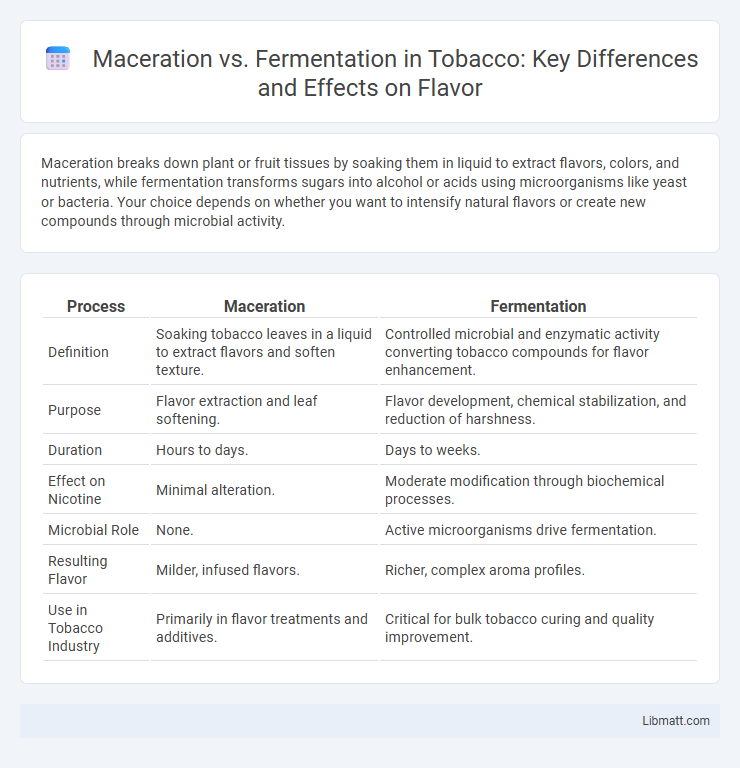Maceration breaks down plant or fruit tissues by soaking them in liquid to extract flavors, colors, and nutrients, while fermentation transforms sugars into alcohol or acids using microorganisms like yeast or bacteria. Your choice depends on whether you want to intensify natural flavors or create new compounds through microbial activity.
Table of Comparison
| Process | Maceration | Fermentation |
|---|---|---|
| Definition | Soaking tobacco leaves in a liquid to extract flavors and soften texture. | Controlled microbial and enzymatic activity converting tobacco compounds for flavor enhancement. |
| Purpose | Flavor extraction and leaf softening. | Flavor development, chemical stabilization, and reduction of harshness. |
| Duration | Hours to days. | Days to weeks. |
| Effect on Nicotine | Minimal alteration. | Moderate modification through biochemical processes. |
| Microbial Role | None. | Active microorganisms drive fermentation. |
| Resulting Flavor | Milder, infused flavors. | Richer, complex aroma profiles. |
| Use in Tobacco Industry | Primarily in flavor treatments and additives. | Critical for bulk tobacco curing and quality improvement. |
Understanding Maceration and Fermentation
Maceration involves soaking crushed fruits, seeds, or plant materials in a liquid to extract flavors, colors, and essential compounds, playing a crucial role in winemaking and herbal preparations. Fermentation is a biological process where microorganisms like yeast or bacteria convert sugars into alcohol, acids, or gases, enhancing flavor complexity and preserving the product. Understanding the distinct roles of maceration and fermentation helps you control texture, taste, and aroma in food and beverage production.
Key Differences Between Maceration and Fermentation
Maceration involves soaking fruit to extract flavors, colors, and aromas, primarily used in winemaking and food preparation, whereas fermentation relies on microbial activity to convert sugars into alcohol or acids, influencing taste and preservation. Maceration is a passive extraction process without chemical transformation, while fermentation triggers biochemical changes essential for producing alcohol or probiotics. Understanding these key differences helps you optimize flavor profiles and texture in culinary or beverage crafting.
The Science Behind Maceration
Maceration involves soaking crushed fruits or plant materials in a liquid to extract flavors, colors, and bioactive compounds through enzymatic and chemical processes. This method enhances the release of anthocyanins and tannins, crucial for the taste and color profile in winemaking and herbal extractions. Unlike fermentation, maceration does not rely on microbial conversion but optimizes solubility and diffusion to intensify the product's sensory attributes.
The Process of Fermentation Explained
Fermentation is a metabolic process where microorganisms like yeast and bacteria convert sugars into alcohol and carbon dioxide, creating unique flavors and preserving the product. Unlike maceration, which involves soaking ingredients to extract color and taste, fermentation actively transforms the chemical composition of your ingredients. This biochemical reaction is essential for producing beverages like wine and beer, enhancing both aroma and texture through the natural conversion of sugars.
Role of Maceration in Winemaking
Maceration in winemaking involves soaking grape skins, seeds, and stems in the juice to extract color, tannins, and flavor compounds essential for the wine's structure and complexity. This process significantly influences the wine's phenolic profile, impacting mouthfeel, aroma, and aging potential. Controlled maceration time and temperature are crucial variables that winemakers adjust to achieve desired wine styles and characteristics.
Fermentation’s Impact on Flavor Profiles
Fermentation significantly influences flavor profiles by converting sugars into alcohol and organic acids, creating complex aromas and enhancing the depth of wines, beers, and other fermented products. You experience nuanced tastes such as fruity, spicy, or earthy notes depending on the yeast strains and fermentation conditions used. Maceration, on the other hand, primarily extracts color, tannins, and phenolic compounds, which contribute to texture and mouthfeel rather than the intrinsic flavor complexity developed during fermentation.
Techniques and Methods for Maceration
Maceration involves soaking fruit, herbs, or other organic materials in a liquid to extract flavors, colors, or nutrients through a gentle process often enhanced by crushing or chopping the ingredients. Techniques for effective maceration include controlling temperature, using solvents like alcohol or sugar solutions, and varying time durations depending on the desired intensity of extraction. Your choice between maceration and fermentation depends on whether you want to capture pure flavors or develop complex chemical changes through microbial activity.
Types of Fermentation Processes
Types of fermentation processes include alcoholic fermentation, lactic acid fermentation, and acetic acid fermentation, each producing distinct biochemical changes in substrates. In contrast, maceration involves the physical soaking of materials to extract flavors or compounds without relying on microbial activity. Your choice between maceration and fermentation depends on whether enzymatic transformation or simple extraction is desired for the final product.
Benefits and Drawbacks of Each Method
Maceration enhances flavor extraction and color intensity in wine and fruit processing but may increase bitterness and requires careful temperature control to avoid spoilage. Fermentation develops complex aromas and natural preservation through yeast activity but demands strict monitoring to prevent unwanted microbial contamination and off-flavors. Both methods influence product quality differently, where maceration excels in extraction efficiency while fermentation contributes to biochemical transformation and preservation.
Choosing the Right Process for Your Product
Maceration and fermentation serve distinct roles in enhancing flavor profiles and chemical composition, with maceration focusing on extracting pigments, tannins, and aromas by soaking raw materials in liquids, while fermentation relies on microbial activity to transform sugars into alcohol or acids. Selecting the right process depends on the desired end product characteristics, such as intensity of flavor, color retention, and alcohol content, crucial for industries like winemaking, perfumery, and food production. For products emphasizing natural extract qualities, maceration is preferred, whereas fermentation suits products requiring biochemical transformation, such as wine, beer, and yogurt.
Maceration vs fermentation Infographic

 libmatt.com
libmatt.com